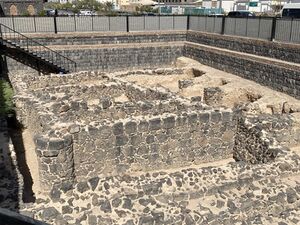The Mosque of Utban b. Malik
 | |
| General Information | |
|---|---|
| Place | Saudi Arabia, Medina, Near Masjid al-Jumuʿa |
| Usage | mosque |
| Religious Aspect | |
| Religious Affiliation | Islam |
| Beliefs | Prayer of the Prophet(s) in this mosque |
| History | |
| Time of Construction | 1 AH. |
| Current State | |
| Status | Demolished |
The Mosque of ʿUtban b. Malik is located in Medina, to the north of Masjid al-Jumuʿa (the Friday Mosque), in an open area facing it. ʿUtban b. Malik was one of the Ansar (Helpers) and companions of Prophet Muhammad (s), and he participated in the Battle of Badr. The Prophet (s) prayed in a corner of his house, and for this reason, ʿUtbān designated that area as his place of prayer.
During the development and urban renewal project in 2015 (1393 SH), the walls of Masjid ʿUtban were demolished, and the remains of the structure were preserved as a historical and tourist site.
ʿUtban b. Malik
Utban b. Malik was one of the Ansar of the Prophet (s) from the Bani Salim tribe of the Khazraj tribe. He was a companion Template:ENote of the Prophet(s) and participated in the Battle of Badr. He passed away in the year 50 AH.[1]
The Prophet’s Prayer in ʿUtbān’s House
Due to his inability to attend congregational prayers, ʿUtbān asked Prophet Muhammad (s) to pray in a corner of his house so that he could designate it as his prayer place, and the Prophet (s) agreed.[2]
Structure of the Mosque
Masjid ʿUtbān ibn Mālik is located to the north of Masjid al-Jumuʿa in an open area facing it.[3] Since around the 8th century AH, the location of this mosque has been identified within the fortress of Muzdalifa.[4] Muzdalifa, during the time of al-Samhūdī (d. 911 AH), was a ruined fortress to the north of Masjid al-Jumuʿa,[5] and al-ʿAbbāsī, a historian of the 10th century AH, confirms this information.[6] Al-ʿAyyāshī, in his travelogue (1073 AH/1662 CE), also found the mosque in a ruined fortress to the north of Masjid al-Jumuʿa, describing it as a small, roofless mosque.[7]
Reconstruction of the Structure
Muhammad b. Ahmad al-Mutri (d. 741 AH), a historian of Medina in the 8th century AH, described the structure as having walls that did not exceed half the height of a person.[4] According to al-Samhūdī (d. 911 AH), the structure mentioned by al-Muṭrī had disappeared by his time, and a group of non-Arabs had rebuilt and revived it in a new form. The roof of the new structure was repaired by Muḥammad ibn Qāwān after its collapse.[8] He was born in 820 AH and passed away in 889 AH, a scholar of ḥadīth and history who lived in Cairo and performed the Hajj multiple times.[9]
Aḥmad al-ʿAbbāsī, a researcher and historian of Medina, claimed that in the year 1036 AH, he discovered this mosque, which was unknown at the time, and carried out minor renovations.[10] Al-ʿAyyāshī, in his travelogue (1073 AH/1662 CE), also found the mosque as a small, roofless structure.[11]
Current Condition of the Mosque
According to Ilyās ʿAbd al-Ghanī, a researcher of Medina’s geography, Masjid ʿUtbān in the year 1417 AH (1996 CE) was an empty plot of land surrounded by a white wall.[12]
Other reports indicate that in 1393 SH (2015 CE/1435 AH), the Saudi government demolished the walls of Masjid ʿUtbān as part of a development and urban renewal project;[13] however, the underlying remains of the structure were preserved as a historical and tourist site.[14]
Historical Images of the Mosque and Its Mihrab
-
Aerial view near Masjid al-Jumuʿa
-
Distant view of the mosque near ʿAbd al-Majīd Street
-
The only existing image of the mosque’s interior and its mihrab
Images After the Saudi Development Project in 2015 CE
Initial Images After Demolition
-
Aerial view of the remaining structure of Masjid ʿUtbān to the north of Masjid al-Jumuʿa
Current Condition of the Mosque
Notes
- ↑ Usd al-Ghāba, Ibn al-Athīr, vol. 3, pp. 359–360.
- ↑ Usd al-Ghāba, Ibn al-Athīr, vol. 3, p. 360; Tārīkh al-Madīna al-Munawwara, Ibn Shabba, p. 71.
- ↑ Masājid al-Athariyya, Ilyās ʿAbd al-Ghanī, p. 120.
- ↑ Jump up to: 4.0 4.1 Al-Taʿrīf bimā ansat al-hijra, al-Muṭrī, p. 134.
- ↑ Wafāʾ al-Wafā, al-Samhūdī, vol. 3, p. 249.
- ↑ ʿUmdat al-Akhbār fī Madīnat al-Mukhtār, al-ʿAbbāsī, p. 182.
- ↑ Al-Riḥla al-ʿAyyāshiyya, vol. 1, p. 390.
- ↑ Wafāʾ al-Wafā, al-Samhūdī, vol. 3, p. 169.
- ↑ Al-Ḍawʾ al-Lāmiʿ li-Ahl al-Qarn al-Tāsiʿ, al-Sakhāwī, vol. 7, p. 54.
- ↑ ʿUmdat al-Akhbār fī Madīnat al-Mukhtār, al-ʿAbbāsī, p. 183.
- ↑ Al-Riḥla al-ʿAyyāshiyya, vol. 1, p. 390.
- ↑ Masājid al-Athariyya, p. 120.
- ↑ Al-Alam News Website, Persian Version and Arabic Version of the Same News.
- ↑ Makkah and Medina Shrines Website.
References
- Aḥmad al-ʿAbbāsī. ʿUmdat al-Akhbār fī Madīnat al-Mukhtār. edited by Muḥammad al-Ṭayyib al-Anṣārī, published by Asʿad Ṭarābuzūnī, n.d.
- ʿAyyāshī, ʿAbd Allāh ibn Muḥammad. Al-Riḥla al-ʿAyyāshiyya. 2006 CE, edited by Saʿīd al-Fāḍilī and Sulaymān al-Qarshī, Abu Dhabi: Dār al-Suwaydī, 1st edition.
- Ibn al-Athīr, ʿAlī ibn Muḥammad al-Jazarī. Usd al-Ghāba fī Maʿrifat al-Ṣaḥāba, Dār al-Kitāb al-ʿArabī, Beirut, Lebanon.
- Muḥammad Ilyās ʿAbd al-Ghanī. Masājid al-Athariyya, Maṭābiʿ al-Rashīd, Medina, 2nd edition, 1419 AH.
- Jamāl al-Dīn Muḥammad ibn Aḥmad al-Muṭrī. Al-Taʿrīf bimā ansat al-hijra min maʿālim dār al-hijra. edited by Sulaymān al-Raḥīlī, Riyadh: Dārat al-Malik ʿAbd al-ʿAzīz, 1426 AH.
- ʿAlī ibn ʿAbd Allāh al-Samhūdī, Wafāʾ al-Wafā bi-Akhbār Dār al-Muṣṭafā. edited by Qāsim al-Sāmarrāʾī, London: Muʾassasat al-Furqān lil-Turāth al-Islāmī, 2001 CE.
- Shams al-Dīn al-Sakhāwī. Al-Ḍawʾ al-Lāmiʿ li-Ahl al-Qarn al-Tāsiʿ. Dār al-Jīl, Beirut, 1412 AH.
- ʿUmar ibn Shabba al-Numayrī. Tārīkh Madīnat Munawwara. n.d., n.p.
- Al-Alam News Website.
- Makkah and Medina Shrines Website.














